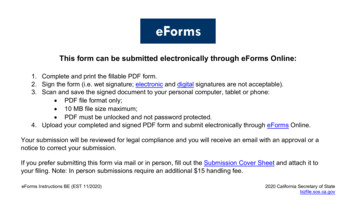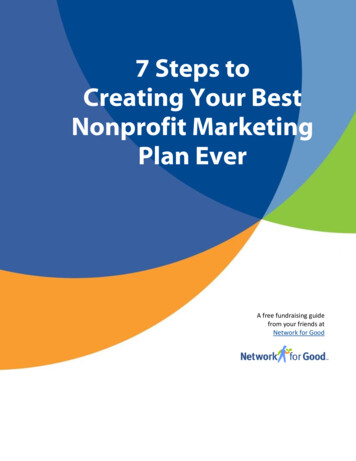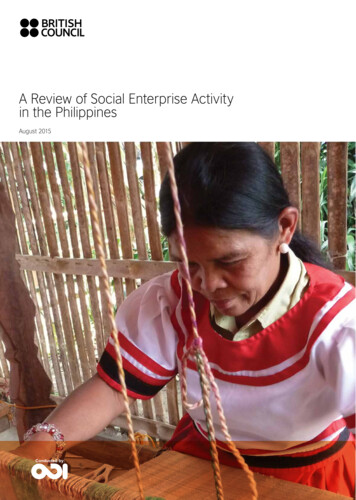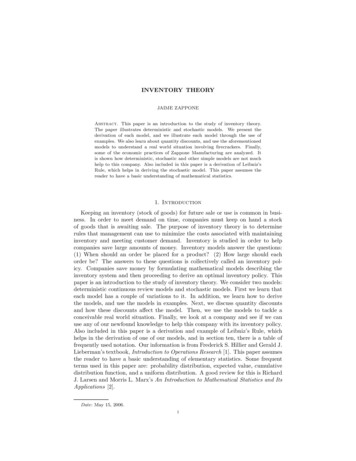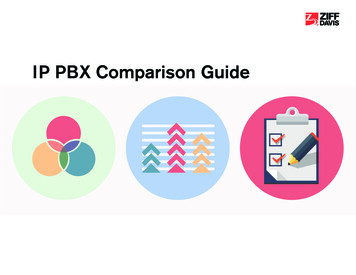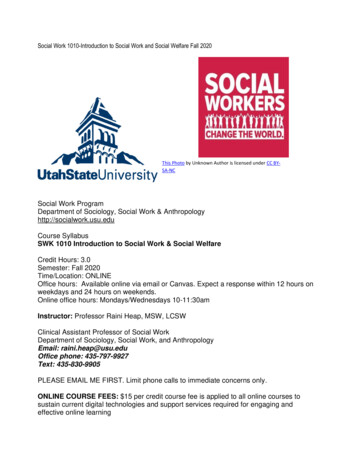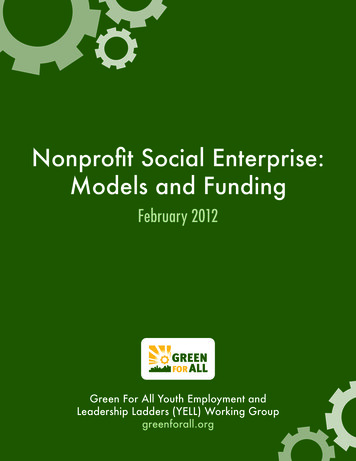
Transcription
Nonprofit Social Enterprise:Models and FundingFebruary 2012Green For All Youth Employment andLeadership Ladders (YELL) Working Groupgreenforall.org
IntroductionA social enterprise is an organization or venture (within an organization) that advances a social mission through market-based strategies. These strategies include receiving earned income in direct exchange for a product, service, or privilege. Social enterprises can come in both nonprofit and for-profitvarieties.While this idea has had a long history (particularly in international development work), it is becoming an increasingly popular idea in the United States. The idea of earned income is attractive tononprofits whose funding sources have shrunk due to broad economic trends like cuts to local andnational social welfare programs, shrinking foundation portfolios, and the increasing need and decreasing resources that come with an economic downturn. In addition to providing an alternativerevenue source, social enterprises provide other benefits, including direct on-the-job (OTJ) trainingopportunities for targeted employees, marketing advantages, and the integration of innovative business frameworks into thinking and planning.At the same time, socially responsible business has become an increasingly profitable and sustainablemodel in the United States. Fair trade companies, green businesses, and worker-owned cooperativeshave shown that for-profit businesses can produce triple bottom line results (producing benefits interms of people, planet and profit). Several states have passed legislation enabling a B-Corporationstatus which protects social enterprises investment in their social mission.1 Foundations, corporationsand even the White House2 are increasingly looking to support social enterprises as a way to sparkand support innovation.At the same time, the enthusiasm about social enterprises often creates unrealistic expectationsfor nonprofits. Earned income is unlikely to fully replace other sources of funding, and probablyshouldn’t. Although using a social enterprise model creates opportunities, there are also trade-offsthat need to be considered.This brief aims to provide an introduction to nonprofit social enterprise models and funding sources.It provides an overview of sources of funds, profiles existing lending programs and successful triplebottom line social enterprises, summarizes lender expectations, and introduces questions and meth1 For a good discussion of the range of business models from nonprofit to for-profit see the “Hybrid Spectrum” developed by Kim Alter of Virtue Ventures: http://www.4lenses.org/setypology/print2 See the website of the Office of Social Innovation and Civic Participation: initiatives/social-innovation-fund.NONPROFIT SOCIAL ENTERPRISE: MODELS AND FUNDINGGreen For All YELL Working GroupPage 2
ods for incorporating a social enterprise model into your existing nonprofit. We have included a listof further resources that will be useful if you decide that the social enterprise model is right for yourorganization.Sources of revenue for social enterprisesNonprofit organizations are primarily financed by two mechanisms: grants and loans. Grants aretraditionally provided by philanthropic foundations or government entities. They can be used for awide range of nonprofit activity and are not expected to be repaid; they generally support all ongoingoperational costs of nonprofit organizations. Loans, on the other hand, are expected to be repaid andare typically used to cover working capital or the purchase of assets.Grants and loans are for different purposes. Grants usually cover startup costs, social subsidies, andadministration, while loans cover working capital or infrastructure investments and are relativelyrare for traditional nonprofits. Loans to nonprofits are typically secured and are increasingly financedthrough impact investment organizations rather than traditional banks. Impact investors seek tomake a profit, but also aim to solve social or environmental challenges.A social enterprise model supplements, not replaces, traditional funding sources for nonprofits. Thefollowing graph3 shows sources of funding (other than earned revenue) for social enterprises in theUS and Canada:3 Source: Community Wealth Ventures, Inc., Social Enterprise Alliance, and The Center for the Advancement of SocialEntrepreneurs. Social Enterprise, A Portrait of the Field. 2011.NONPROFIT SOCIAL ENTERPRISE: MODELS AND FUNDINGGreen For All YELL Working GroupPage 3
There are few nonprofits that can operate without philanthropic support, as revealed by a survey ofnonprofit business models4:There were several funding models we thought we might find, but didn’t, [including] nonprofits that operated on a strictly fee-for-service model in either a business-to-business ordirect-to-consumer fashion, without important supplementary fundraising (from membersor prior beneficiaries) or underlying government support It is our belief that these types ofapproaches do not lend themselves to large-scale, sustained nonprofit advantage over forprofit entities.There are several kinds of loans available to nonprofits. These include personal loans (from friendsand family, typically up to 20,000), microloans (from 500 to 100,000), bank loans (typically up to 3million), and government-backed loans. Loans can be secured (tied to collateral that can be seized inthe event of a default) or unsecured. Secured loans are generally available at lower interest rates.Traditionally, lending decisions are made on “three Cs”: capacity (cash flow), character (management), and capital (collateral). These are meant to minimize the risk of default, defined as failure torepay a lender in full. These lending criteria, especially when money supply is tight, prevent thosewith little financial history from receiving needed money.A variety of lending organizations make it their mission to provide capital to worthy social enterprises. These include social investors, impact investment lenders, microfinance organizations, andCommunity Development Financial Institutions (CDFIs). Several of these lending organizations willbe profiled in the following section.4 Foster, William Landes. Ten Nonprofit Funding Models. Stanford Social Innovation Review. Spring 2009. Availableat http://www.ssireview.org/articles/entry/ten nonprofit funding models/.NONPROFIT SOCIAL ENTERPRISE: MODELS AND FUNDINGGreen For All YELL Working GroupPage 4
Profiles of organizations that support nonprofit social enterprisesThis section includes snapshot profiles of a few major lenders. It is not intended to be a comprehensive survey of lending programs for nonprofit social enterprises (NSEs)5. It is important that youunderstand your needs and your lender’s requirements before seeking any loans.RSF Social Finance: Since 1984, RSF has loaned over 230 million to both nonprofit and for-profit organizations. Borrowers get financing to meet their capital needs and the opportunity to join a community of nonprofit and for-profit social enterprises. Nonprofits must have a mission in one of three impactareas (food/agriculture, education/arts, or ecological stewardship), strong governance, sustainableapproaches, fair-trade workforce principles, and a commitment to social good and environmental responsibility. The RSF Prime interest rate for “core lending” is currently at 5% (in 2011), and is adjustedquarterly based on joint recommendations from investors and borrowers. Loans typically are secured.Applicants should have three years of operating history, a strong management team, and a profitable(or soon-to-be profitable) enterprise. Loans typically range from 200,000 to 3 million.6Roberts Enterprise Development Fund (REDF): Since 1997, REDF has provided funding and businessassistance to a carefully selected portfolio of social enterprises that employ disconnected youth andadults who are overcoming barriers to employment. REDF’s support for portfolio companies includesunrestricted and restricted grants, staff consulting, and human capital. REDF does not provide loans.Nonprofit Finance Fund (a CDFI): Since 1980, Nonprofit Finance Fund (NFF) has made over 235 million in loans to nonprofits in support of over 1.3 billion in projects. Their financing helps nonprofitsmanage growth, build and renovate facilities, balance government contract payments, manage cashflow and bridge capital campaigns. They aim to help organizations better serve their clients and communities. NFF loans typically range between 100,000 and 2 million.Echoing Green: Since 1987, Echoing Green has been supporting social entrepreneurs through seedmoney grants. Since their inception, they have invested over 30 million in seed grants to over 500social entrepreneurs. Through their Echoing Green Fellowship, they provide a stipend of 60,000 for aone-person social enterprise or 90,000 for a two-person staffed social enterprise. These funds are paid5 Some other organizations include Draper Richards Kaplan Foundation, Skoll Foundation, Omidyar Network, Acumen Fund, and Schwab Foundation6 For more information, see .NONPROFIT SOCIAL ENTERPRISE: MODELS AND FUNDINGGreen For All YELL Working GroupPage 5
over a two-year period. In addition to seed capital, they also offer social entrepreneurs a stipend formedical insurance and access to a number of free business support services.Is the social enterprise model for you?Social enterprises provide up to three forms of returns: social, environmental, and financial. Existingorganizations should understand each of these returns before implementing a social enterprise model.Think of the challenges of running an organization when there is only one goal – for example, maximizing profit, or hiring people with barriers to employment. Imagine how much more complicatedthat gets when you are balancing two or three goals, and imagine what the trade-offs could look like.A social enterprise model may not be right for some organizations. There are several questions to consider before adopting such a model in an existing nonprofit:1. Is our organization prepared to take on the risk, including risk of failure, associated with growing a business?2. Is our organization willing to accept a possible dilution of social or environmental goals?3. Is our organization willing and able to be entrepreneurial? Can we reorganize or invest in theorganization’s infrastructure?4. Do we clearly understand the costs and benefits associated with this venture?5. What returns do we desire? What does success look like?6. Is there a reasonable chance of success? Do we have a true competitive advantage? This is particularly important for NSEs that start off with loans as their primary source of financing.7. Do we have appropriate industry expertise? Or do we have capacity to hire for it?8. Does the board understand the risks, timeline, and costs associated with starting a SE and doesit full support this endeavor? A split board, over time, will slowly work against the SE.If the organization determines that creating a social enterprise makes sense, the following questionsmay help to discern which of the organization’s existing services can be monetized and which shouldremain social benefits:1. Would others pay for this service?2. Are the existing clients that use this service deserving of social (philanthropic) subsidy? CanNONPROFIT SOCIAL ENTERPRISE: MODELS AND FUNDINGGreen For All YELL Working GroupPage 6
they afford market rates?3. Can this service, with or without subsidy, compete in the private market?4. Would offering this service dilute the organization’s social mission?5. Is there an opportunity for on-the-job training opportunities through this service?6. Can philanthropy, rather than loans, support these existing services?7. Would charging for this product help or hurt interactions with the clients?8. Can the organization effectively manage this business transaction?The costs and returns of normal businesses and social enterprises differ. Figure 1 offers an illustrationof these differences7.Figure 1. Differences in costs for social enterprises versus for-profit businesses.In addition to social and financial returns, NSEs have both business- and mission-related costs. Mission-related costs can be offset by subsidies such as grants but are burdened by both mission-relatedcost of goods sold (COGS) and mission-related expenses. Social benefits are also hard to quantify in7 Source: Haider, Samra. “Social Enterprise 101.” Presentation to National Transitional Jobs Network and Green forAll Communities of Practice. 9/9/2010.NONPROFIT SOCIAL ENTERPRISE: MODELS AND FUNDINGGreen For All YELL Working GroupPage 7
financial terms.Furthermore, these social and financial costs are different and should be managed separately. Figure28 shows REDF’s recommendations for managing costs9.Figure 2. Suggestions for identifying and managing social costs in a social enterprise.There are a number of factors to consider before pursuing a social enterprise model. This brief hasprovided a quick glimpse into some of those key issues. We suggest careful consideration of these issues before deciding if this model will work for your venture, whether existing or planned. There area number of resources, some of which are referenced here, that can help in determining whether ornot this model will work for you. The following section highlights some successful social enterprisemodels.8 Ibid.9 For information on setting up a social enterprise, please see REDF’s “Social Enterprise Start Up Kit” available ocial-enterprise-start-up-kit.NONPROFIT SOCIAL ENTERPRISE: MODELS AND FUNDINGGreen For All YELL Working GroupPage 8
Case studies:triple bottom line social enterprisesRecycleForce (formerly Workforce Inc.), Indianapolis, INA RecycleForce participant says: “We’re helping to save the world and it feels good! We’re not just recycling“stuff”, people too!” Photo courtesy of RecycleForce.RecycleForce (formerly known as Workforce, Inc.) is a 501(c)(3) nonprofit that operates as a socialenterprise. Their stated mission is twofold: (1) become the most comprehensive recycling hub inIndianapolis, Indiana; and (2) help those returning from prison gain immediate, legitimate earningscombined with a broad array of social support.In 2006, RecycleForce (RF) started providing recently released offenders with transitional jobs inthe emerging electronic waste recycling industry. Waste is one of the top three exports of the UnitedStates. Recycling businesses in developing countries gather raw materials from US “waste” to produce goods, many of which are resold to the US. Given this, it makes sense to process or add valueto the waste before it goes overseas to be used for manufacturing. By doing so, RF can create jobs andNONPROFIT SOCIAL ENTERPRISE: MODELS AND FUNDINGGreen For All YELL Working GroupPage 9
reduce the risk of harm due to a lack of regulatory oversight of recycling processes in some developing countries. This program seeks to keep as much electronic waste as possible out of landfills andrecover the waste so that it can be reused in industry.Since its launch in 2006, RF has grown from two workers and 600,000 pounds of processed materials to more than 35 employees and 3.4 million pounds of processed recyclables annually. During thistime, the program has employed nearly 400 people and paid over 2.3 million in wages. Only 28%of participants have been returned to prison, as compared to an average rate of around 50% in Indianapolis. Employees who owe child support pay an average of 1,300 in child support during the 4months of transitional employment, and most report improved relationships with their children Mostare proud to show their kids they can work in the mainstream economy, many for the first time intheir lives.Although RF began specializing in recycling electronic waste, it has expanded to offer recycling services for a whole host of materials, including plastic, aluminum, paper and cardboard. Since its inception, RF has helped clean up our environment by processing a total of 11 million pounds of recyclablematerial.RF uses its revenues from the recycling business to help formerly incarcerated individuals rebuildtheir lives by providing gainful employment. As its recycling operation has grown, so has RF’s capability to employ and train hundreds of ex-offenders, successfully guiding their re-entry back intothe community. RF participants benefit not only from jobs but also from state programs to improveliteracy and math skills, as well as “contextualized learning” opportunities with accompanying certifications (e.g., forklift operation or HazMat handling).Formerly incarcerated individuals have the odds stacked against them upon their release. Most haveno job and no home to return to. Without these foundational elements, the rate of reoffending and returning to the criminal justice system is higher than necessary. In fact, more than half of all ex-offenders returning to Indianapolis/Marion County in 2009 ended up back in the prison system.RF’s social enterprise revenues totaled over 1 million in 2010. Their goal is for the venture to become60 to 70% self-supporting through the sale of recycled material. In fiscal year July 2010 – June 2011,sales supplied 60 percent of income.RF also receives funding from philanthropic organizations and public contracts. RF has been awardeda 5.5 million random assignment grant from the U.S. Department of Labor to test the validity of theirNONPROFIT SOCIAL ENTERPRISE: MODELS AND FUNDINGGreen For All YELL Working GroupPage 10
model as compared to “services as usual” for ex-offenders coming home. MRDC10, one of the na-tion’s premier evaluation firms, will study the experiences of 1,000 people. The study will help informgovernment on the efficacy of social enterprise as a means to help people reenter society and succeedafter incarceration. RF is also beginning to offer fee for service technical assistance to support morerecycling based social enterprises like themselves to get off the ground in other communities nationwide.RF’s Executive Director, Gregg Keesling, notes that it is a challenge to get stakeholders to understandthat they must function as both a social venture and a business. People who see RF solely as a business may not understand that RF has added costs and inefficiencies associated with employing exoffenders and trying to get them back into productive lives. At the same time, those who see RF as anonprofit with a social mission may not understand why RF cannot serve all people who need help orwhy it may make decisions that are as much focused on business needs as social needs.Generation Water, Los Angeles, CAEvery year, Southern California imports approximately two-thirdsof its water from the Western U.S., while its population grows by150,000 people. The region’s long-term water usage patterns areunsustainable. Over time, the region must develop new sources ofwater, including (1) conservation – getting people to use less water;(2) increasing efficiency – making better use of the water we have; (3)recycling water; and (4) infiltrating rainwater into local aquifers.Unemployment among young adults is high. Young people, regardless of education, often struggle to find a career entry point. At theFigure 3. Generation Wateremployees at work. Source:www.generationwater.orgsame time, water utilities are facing a retirement crisis as baby boomers retire.Generation Water (GW) is focused on developing a pipeline of diverse, well-qualified young peoplefor the career opportunities of the green economy (Figure 3). GW achieves this mission in two ways:10 For more information on MRDC, go to www.mrdc.org. Note: “MRDC” originally stood for “Manpower ResearchDevelopment Corporation” (in 1974), but the company changed its registered corporate identity to “MRDC” (in2003).NONPROFIT SOCIAL ENTERPRISE: MODELS AND FUNDINGGreen For All YELL Working GroupPage 11
1. By completing demonstration projects that reduce water use, recharge groundwater, and improve watershed health through ecosystem renewal.2. By providing young people, ages 18-24, with training and on-the-job work experience as theybegin careers in water conservation, irrigation, sustainable landscaping, and related areas.A subsidiary of the nonprofit Los Angeles Infrastructure Academy, Generation Water was created asa social enterprise in 2009. Its initial client was the Los Angeles Department of Water and Power. Thefirst project was to conduct water surveys of 120 high schools and middle schools in the Los AngelesUnified School District (LAUSD).Today, GW has developed three service areas:1. Irrigation Surveys and Repair: GW conducts GIS-based irrigation surveys for schools and parks.These surveys identify all broken irrigation equipment and compare water usage patterns andequipment to the standards set by California’s Water Efficient Landscape Ordinance. GW alsoinstalls weather-based irrigation controllers and repairs broken irrigation equipment. Clientsare typically water districts interested in reducing aggregate water usage on large landscapes.To date, GW teams have successfully completed more than 160 school and park irrigationsurveys, located and inventoried more than 400 irrigation controllers and 5,300 valves, andcataloged more than 100,000 sprinklers, including more than 14,000 malfunctioning or brokensprinklers.2. Rainwater Infiltration: GW is installing 1,000 residential “rain gardens” to infiltrate water intothe ground from roofs as a mechanism to recharge aquifers and improve the health of the localwatershed.3. Habitat Restoration: GW is removing invasive plant species and restoring native vegetation toa local regional park. Habitat restoration promotes watershed health and fosters the return oflocal flora and fauna.GW applied for and won a 2.5 million Green Innovation Challenge grant from the State of California in 2009 in partnership with the Los Angeles Conservation Corps and several other environmentalnonprofit groups. Together, these groups are responsible for training 175 young adults, ages 18-24,and placing 70% of them into industry positions.Generation Water started as a program for at-risk high school students, but as the technical complexity of the work has increased (and as the Green Innovation Challenge grant has provided new op-NONPROFIT SOCIAL ENTERPRISE: MODELS AND FUNDINGGreen For All YELL Working GroupPage 12
portunities), the GW workforce has become older and more experienced. Today, 80% of the 30 employees are either in college or are recent college graduates. Many of the college students are studying(or have studied) environmental science, biology, urban planning, landscape architecture, or relatedfields. GW team members learn a range of skills including irrigation, water management, sustainablelandscaping, construction, Geographic Information Systems, database entry and management, marketing, and business management. GW is becoming a nonprofit business focused on water management by the next generation of water employees for the next generation.In addition to gaining paid on-the-job experience, young people participate in training sessions on irrigation, water management, horticulture, sustainable landscaping, and other topics. They also attendindustry meetings and trade shows. GW also hosts occasional overnight field trips and leadershipretreats. Team members also routinely outline their goals and receive performance feedback.GW’s business model currently depends on a mix of earned income, government workforce development funding, and corporate donations. For 2011-12, the mix is budgeted to be 57% earned income,37% government funding, and the remainder philanthropic or other funding. Generation Water’s goalis to be 100% self-sufficient with earned income by June 2012.Rising Sun Energy Center, Berkeley, CARising Sun Energy Services is a social enterprise run by Rising SunEnergy Center, a 501(c)3 non-profit organization. The enterpriseoffers bridge employment that provides graduates of Rising Sun’sGreen Energy Training Program (GETS) the opportunity to put theirtraining into practice through paid employment with Rising Sun’sown social enterprise on building performance, Rising Sun EnergyServices. The GETS training is designed to prepare individuals whohave barriers to employment for entry-level and semi-skilled positions in the residential energy efficiency industry (Figure 4). Througha combination of lecture and hands-on instruction in the classroom,lab and field settings, participants are introduced to the fundamentalsof building science and industry-accepted energy efficiency upgradepractices. The on‐the‐job experience Rising Sun Energy ServicesFigure 4. A GETS participantperforms a blower door test.www.risingsunenergy.org.Crew Members gain through auditing and retrofitting homes makesNONPROFIT SOCIAL ENTERPRISE: MODELS AND FUNDINGGreen For All YELL Working GroupPage 13
them much more attractive to potential employers. Rising Sun Energy Services Crew Members areemployed by Rising Sun Energy Center on a part‐time basis for a period of three to nine months andare paid 15 to 17 per hour. The Rising Sun Energy Services program goals are: To provide GETS graduates the opportunity to conduct home performance testing and remediation work to hone the technical and professional skills gained in their GETS training; To assist GETS graduates by giving them “bridge employment” until they can be permanently placed; To provide energy upgrades to home-owners across Alameda, Contra Costa and MarinCounty at a significantly reduced cost; To improve the efficiency, durability, health, safety, and comfort of homes within the community; To stimulate interest and demand for energy efficiency work to encourage the creation ofmore jobs; To assist local governments in reaching their Climate Action Plan (CAP) goals.Rising Sun’s GETS Energy Services provides energy efficiency services to moderate-income homes inBerkeley and Richmond, CA with the assistance of subsidies and incentives from local governmentsand the utilities. In addition they provide similar energy efficiency services throughout Alameda,Contra Costa and Marin County with incentives through the utilities. Rising Sun provides this subsidized service to residents who benefit by paying for the service at a reduced rate. The revenue generated from the retrofit service is used to fund the social enterprise, including wages for participants(employees), operational and administrative costs, inventory, marketing, and all other costs associatedwith doing business. Additional funds are raised via government and foundation grants to cover thecosts of additional training, case management, support services, and job coaching and development.ConclusionThe recent economic downturn has lead to a decline in funding for nonprofits. Nonprofit organizations are finding it increasingly difficult to access public and philanthropic funding for their programs. Some nonprofits are using the social enterprise model to create self-sustaining programs bycharging a fee for their services. This model provides the potential to diversify funding sources andNONPROFIT SOCIAL ENTERPRISE: MODELS AND FUNDINGGreen For All YELL Working GroupPage 14
sustain financial support for mission-based work. However, significant risks accompany this potential. Organizations should carefully consider the benefits, risks, and alternative options before deciding to create a social enterprise. Organizations that have decided to create a social enterprise shouldbe thoughtful in balancing their nonprofit mission with their profit-driven goals and realistic abouttheir organizational capacity to initiate a business endeavor. There are various examples of nonprofitsusing social enterprise models to create green jobs for low-income communities and residents withbarriers to employment. If the social enterprise model looks promising for your organization, weencourage you to look into further resources and consider the lessons learned from existing organizations.Further Social Enterprise ResourcesAshoka. Print Room.http://www.ashoka.org/printroomAspen Institute. Program on Philanthropy and Social Innovation nprofit-philanthropyCenter for Advancement of Social Entrepreneurship (CASE) at Duke University. General Social Entrepreneurship ralresources/index.htmlCommunity Wealth Ventures. .htmlCommunity Wealth Ventures, Inc., Social Enterprise Alliance, and The Center for the Advancement ofSocial Entrepreneurs. Social Enterprise, A Portrait of the Field. 20Study%20FINAL.pdfHarvard Business Review. Social Enterprise Case Studies, Articles, and titute for Social Entrepreneurs.http://www.socialent.org/Free org/More information about technical assistance can be provided by contacting info@recycleforce.comREDF. Learn from REDF.http://www.redf.org/learn-from-redfNONPROFIT SOCIAL ENTERPRISE: MODELS AND FUNDINGGreen For All YELL Working GroupPage 15
RSF Social Finance. ng/Social Enterprise Alliance. What is Social ial-enterpriseSocial Enterprise Toolbelt. Social Enterprise Resources.http://www.setoolbelt.org/Stanford Social Innovation Review.http://www.ssireview.org/Virtue Ventures. Introduction to Understanding and Accessing Social Investment: A Brief Guide for SocialEntrepreneurs and Development Practitioners. 2009http://www.virt
that gets when you are balancing two or three goals, and imagine what the trade-offs could look like. A social enterprise model may not be right for some organizations. There are several questions to con-sider
